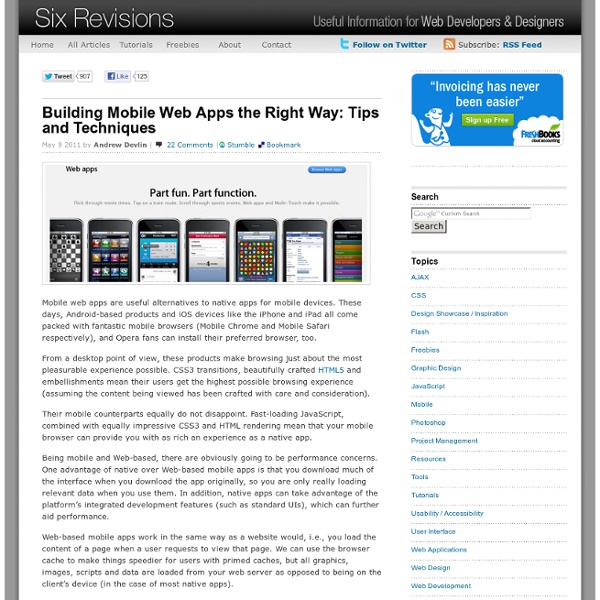Building Mobile Web Apps the Right Way: Tips and Techniques

Pretenders: Why mobile Web apps should stop trying to act like native apps « cvil.ly
There are a lot of great reasons to build a mobile Web app just as there are a lot of great reasons to build any Web app and I’m certainly not here to continue the great Web versus native app debate. It’s not native versus Web, it’s both and it depends on your situation. But what I’m here to talk about are the pretenders. Pretenders are mobile Web apps that try to replicate the native experience. You’ve no doubt seen Web apps with iPhone-style back buttons, awkward attempts at implementing gestures, laggy scrolling and the like. Pretenders have problems They don’t meet user expectations Users of pretender apps get an experience that falls squarely in the uncanny valley — it looks like a native app, but something isn’t quite right. They are a huge drain on development resources Development teams can spend countless hours trying to make the Web act native. Embrace the Web If you’ve decided to deliver your app via the Web, you should embrace the capabilities and constraints of the Web.
Why Mobile Apps Will Soon be Dead
It’s hard to imagine Apple’s App store – 50 million users, 400,000 apps, 10 billion downloads – being threatened with extinction, but it’s not as if Tyrannosaurus Rex had a clue its demise was imminent until the process was well underway, either. We know that empires crumble: what’s interesting is how. Right now pundits are focused on the threat of Android. Apple is still shipping plenty of iPhones, but even Steve Jobs must recognize that if his were a Roman empire, the numberless device manufacturers selling Android devices are the metaphorical barbarians at the gates. The real threat are web apps. Steve Jobs thought web apps were the future too, in 2008 when he announced that the iPhone would have plenty of apps – all of them available through the browser. Here’s how Brian Kennish, formerly an engineer at Google and now something of a punk-rock privacy-protecting developer, put it in a recent email: “One word: distribution.
Activate TheBraiin Pro
Activating TheBrain Pro To activate TheBrain Pro features simply restart TheBrain. TheBrain Pro features will be automatically enabled.To verify activation, open the About TheBrain (under the Help menu on Windows and Linux and under TheBrain menu on OS X). Troubleshooting If the Pro Edition does not automatically activate then check that you are logged in using the same account your purchase is registered with. Open Preferences (under the Options menu on Windows and Linux and under TheBrain menu on OS X) and look at the content of the “Logged in as” area. When you log in with the correct account, TheBrain Pro features will be automatically activated.
Related:
Related:



